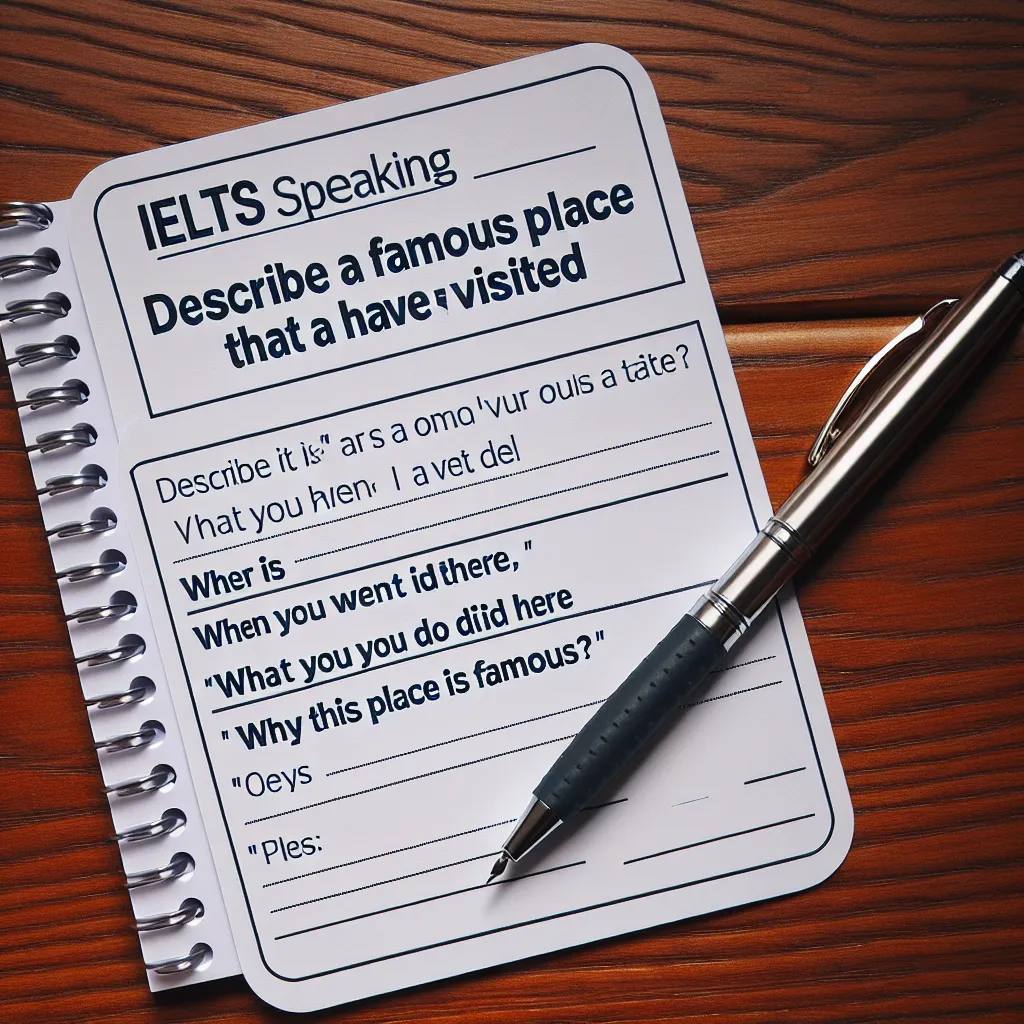The IELTS Speaking test often includes questions about travel experiences, particularly famous places candidates have visited. This topic allows examiners to assess your ability to describe locations, express personal opinions, and discuss cultural experiences. Let’s explore how to effectively answer questions about a famous place you’ve visited to achieve a high band score in your IELTS Speaking test.
Nội dung bài viết
Part 1: Introduction and Interview
In Part 1, the examiner may ask general questions about travel and famous places. Here are some common questions and sample answers:
- Do you like traveling?
- What’s your favorite type of vacation?
- Have you visited any famous places in your country?
Let’s focus on question 3:
Sample answer (Band 7-8):
“Yes, I have. One of the most famous places I’ve visited in my country is the ancient city of Hue, which was once the imperial capital of Vietnam. It’s renowned for its historic architecture and rich cultural heritage.”
Sample answer (Band 8-9):
“Absolutely. I’ve had the privilege of visiting several iconic locations in my country, but the one that stands out the most is the ancient city of Hue. As the former imperial capital of Vietnam, it’s a treasure trove of historical significance, boasting magnificent citadels, ornate pagodas, and the picturesque Perfume River. The city’s blend of royal architecture and natural beauty makes it a truly captivating destination.”
Part 2: Long Turn (Cue Card)
Here’s a sample cue card related to describing a famous place:
Describe a famous place that you have visited
You should say:
- Where it is
- When you went there
- What you did there
And explain why this place is famous
 IELTS Speaking Cue Card
IELTS Speaking Cue Card
Sample answer (Band 7-8):
“I’d like to talk about my visit to the Taj Mahal in Agra, India. I went there last summer with my family during a two-week trip around northern India.
The Taj Mahal is located in the city of Agra, about 200 kilometers southeast of New Delhi. We arrived early in the morning to avoid the crowds and the heat. As soon as we entered the complex, I was struck by the sheer beauty and grandeur of the white marble mausoleum.
During our visit, we explored the main building and its surrounding gardens. We took a guided tour to learn about the history and architecture of the monument. I remember being fascinated by the intricate carvings and inlaid precious stones on the walls.
The Taj Mahal is famous for several reasons. Firstly, it’s considered one of the most beautiful buildings in the world and a masterpiece of Mughal architecture. It was built by Emperor Shah Jahan as a memorial for his beloved wife, Mumtaz Mahal, which adds a romantic element to its history. Additionally, it’s a UNESCO World Heritage site and one of the New Seven Wonders of the World, attracting millions of visitors annually.”
Sample answer (Band 8-9):
“I’d be delighted to share my experience of visiting the awe-inspiring Taj Mahal in Agra, India. This architectural marvel left an indelible impression on me when I had the opportunity to explore it last summer during a cultural immersion trip to northern India with my family.
Situated in the historical city of Agra, approximately 200 kilometers southeast of the bustling capital, New Delhi, the Taj Mahal stands as a testament to eternal love. We made a point of arriving at the crack of dawn, not only to beat the swelling crowds but also to witness the ethereal beauty of the monument as it was bathed in the soft light of sunrise.
Our visit was nothing short of mesmerizing. We embarked on a guided tour that delved into the rich tapestry of history and architectural brilliance that the Taj Mahal embodies. I was particularly captivated by the intricate craftsmanship evident in every detail – from the delicate inlay work of precious stones to the perfectly symmetrical design of the entire complex. The serene Yamuna River flowing behind added to the picturesque setting.
The Taj Mahal’s fame stems from multiple factors that coalesce to make it a truly unparalleled wonder. Primarily, it’s revered as one of the most exquisite examples of Mughal architecture, seamlessly blending elements from Islamic, Persian, and Indian architectural styles. Its status as a symbol of enduring love – commissioned by Emperor Shah Jahan as a mausoleum for his beloved wife Mumtaz Mahal – adds a layer of romance to its historical significance. Furthermore, its recognition as a UNESCO World Heritage site and inclusion among the New Seven Wonders of the World have cemented its position as a global cultural icon, drawing millions of visitors from across the globe each year.”
Follow-up questions:
- What was the most memorable part of your visit?
- How has tourism affected this famous place?
Sample answer for question 1 (Band 8-9):
“The most unforgettable aspect of my visit was undoubtedly the moment I first laid eyes on the Taj Mahal as the sun was rising. The way the first rays of sunlight played on the white marble, creating an almost ethereal glow, was truly breathtaking. It was a visual spectacle that seemed to epitomize the monument’s reputation as a wonder of the world. This experience was enhanced by the relative tranquility of the early morning, allowing for a more intimate and reflective encounter with this architectural masterpiece.”
Sample answer for question 2 (Band 8-9):
“Tourism has had a profound impact on the Taj Mahal, bringing both positive and negative consequences. On the positive side, the influx of visitors has significantly boosted the local economy, creating numerous jobs and spurring development in Agra. The revenue generated has also contributed to the preservation and maintenance of the monument.
However, the sheer volume of tourists has posed challenges. The constant foot traffic has led to concerns about wear and tear on the delicate marble floors and intricate carvings. Additionally, increased air pollution from nearby industries and vehicles, partly driven by tourism, has been causing the marble to yellow, prompting authorities to implement strict conservation measures.
To mitigate these issues, the government has introduced measures such as limiting visitor numbers, implementing time-restricted visits, and promoting sustainable tourism practices. These efforts aim to strike a balance between preserving this invaluable heritage site and allowing people from around the world to experience its beauty.”
Part 3: Two-way Discussion
In Part 3, the examiner will ask more abstract questions related to the topic. Here are some possible questions and sample answers:
- How do famous landmarks contribute to a country’s identity?
- What are the challenges of preserving historical sites in the modern world?
- Do you think virtual tours of famous places can replace actual visits?
Let’s focus on question 1:
Sample answer (Band 7-8):
“Famous landmarks play a significant role in shaping a country’s identity. They often represent important historical events or cultural values that are unique to that nation. These landmarks become symbols that people associate with the country, both domestically and internationally. For example, when people think of France, the Eiffel Tower often comes to mind immediately. These iconic structures also attract tourists, which can boost the country’s economy and cultural exchange.”
Sample answer (Band 8-9):
“Famous landmarks are integral to a country’s identity, serving as tangible representations of its history, culture, and achievements. These iconic structures often encapsulate the essence of a nation, becoming visual shorthand for its values and aspirations.
Firstly, landmarks act as physical embodiments of a country’s historical narrative. They stand as testaments to significant events, architectural prowess, or cultural traditions that have shaped the nation. For instance, the Great Wall of China not only showcases remarkable engineering but also symbolizes the country’s ancient defensive strategies and the perseverance of its people.
Moreover, these landmarks often become cultural ambassadors, instantly recognizable symbols that evoke a sense of place and identity. The Statue of Liberty, for example, is not just a colossal structure in New York Harbor; it embodies the ideals of freedom and opportunity that are fundamental to the American ethos.
Furthermore, famous landmarks can foster national pride and unity. They provide citizens with a shared cultural reference point, a common heritage that transcends regional or social divides. This shared identity can be particularly powerful in diverse, multicultural nations.
Lastly, these iconic sites often serve as economic catalysts, attracting tourists and stimulating local economies. While this aspect is more pragmatic, it nonetheless contributes to how a country is perceived and experienced by both visitors and residents.
In essence, famous landmarks are not mere tourist attractions; they are potent symbols that distill complex national identities into visually striking and emotionally resonant forms, playing a crucial role in how a country is perceived and understood both internally and on the global stage.”
Key Vocabulary and Phrases for High Scores
To enhance your speaking performance, incorporate these advanced words and phrases:
-
Awe-inspiring (adjective) /ɔː-ɪnˈspaɪə.rɪŋ/: Extremely impressive or daunting.
Example: “The Grand Canyon is an awe-inspiring natural wonder.” -
Epitomize (verb) /ɪˈpɪt.ə.maɪz/: To be a perfect example of something.
Example: “The Colosseum epitomizes the grandeur of ancient Roman architecture.” -
Indelible impression (phrase) /ɪnˈdel.ɪ.bəl ɪmˈpreʃ.ən/: A lasting effect or influence.
Example: “Visiting the Louvre left an indelible impression on my appreciation for art.” -
Cultural immersion (phrase) /ˈkʌl.tʃər.əl ɪˈmɜː.ʃən/: The process of deeply engaging with a different culture.
Example: “My trip to Japan was a true cultural immersion experience.” -
Architectural marvel (phrase) /ˌɑː.kɪˈtek.tʃər.əl ˈmɑː.vəl/: A building that inspires wonder due to its design or construction.
Example: “The Sydney Opera House is widely regarded as an architectural marvel.”
 IELTS Speaking Vocabulary
IELTS Speaking Vocabulary
Examiner’s Advice
To achieve a high score in the IELTS Speaking test when describing a famous place:
- Use a wide range of vocabulary, including less common words and idiomatic expressions.
- Demonstrate your ability to use complex grammatical structures accurately.
- Provide detailed descriptions and personal insights to fully develop your answers.
- Maintain fluency by speaking at a natural pace without long pauses.
- Organize your ideas coherently, especially in Part 2’s long turn.
- Show your ability to discuss abstract concepts in Part 3, not just personal experiences.
Remember, practice is key. Regularly describe places you’ve visited to friends or record yourself speaking to improve your fluency and confidence.
For more tips on acing the IELTS Speaking test, check out our guides on describing a time when you traveled to a foreign country and describing a place you visited that was very crowded.
By following these strategies and incorporating advanced vocabulary, you’ll be well-prepared to describe famous places you’ve visited in your IELTS Speaking test, helping you achieve the band score you’re aiming for.


